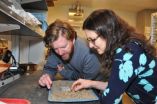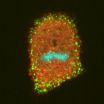(Press-News.org) A heartier appetite is linked to more rapid infant growth and to genetic predisposition to obesity, according to two papers published in JAMA Pediatrics today (Monday).
The studies investigated how weight gain is linked to two key aspects of appetite, namely lower satiety responsiveness (a reduced urge to eat in response to internal 'fullness' signals) and higher food responsiveness (an increased urge to eat in response to the sight or smell of nice food).
The first paper reveals that infants with a heartier appetite grew more rapidly up to age 15 months, potentially putting them at increased risk for obesity.
The authors used data from non-identical, same-sex twins born in the UK in 2007. Twin pairs were selected that differed in measures of satiety responsiveness (SR) and food responsiveness (FR) at 3 months, and their growth up to age 15 months was compared. Within pairs, the infant who was more food responsive or less satiety responsive grew faster than their co-twin.
The more food responsive twin was 654g heavier (1.4lbs) than their co-twin at six months and 991g heavier (2.1lbs) at 15 months. The less satiety responsive twin was 637g heavier (1.4lbs) than their co-twin at six months and 918g heavier (2lbs) at 15 months.
"Obesity is a major issue in child health" says Professor Jane Wardle, lead author of the study from the UCL Health Behaviour Research Centre. "Identifying factors that promote or protect against weight gain could help identify targets for obesity intervention and prevention in future. These findings are extremely powerful because we were comparing children of the same age and same sex growing up in the same family in order to reveal the role that appetite plays in infant growth.
"It might make life easy to have a baby with a hearty appetite, but as she grows up, parents may need to be alert for tendencies to be somewhat over-responsive to food cues in the environment, or somewhat unresponsive to fullness. This behaviour could put her at risk of gaining weight faster than is good for her."
The second JAMA Pediatrics paper, in collaboration with King's College London, sheds further light on the way that appetite, particularly low satiety responsiveness, acts as one of the mechanisms underlying genetic predisposition to obesity.
The researchers accessed data from 2,258 10-year-old children born in the UK between 1994 and 1996. The team created a polygenic obesity risk score (PRS) for each child to estimate their genetic susceptibility to obesity, by adding up the number of higher-risk alleles from 28 obesity-related genes. Higher PRS scores indicated a higher genetic predisposition to obesity.
The PRS scores were then examined to determine the correlation with the children's satiety responsiveness and adiposity (body fatness).
"As expected, we found that children with a higher PRS score (more obesity-risk' genetic variants) were likely to have larger BMI and waist circumference," says Dr Clare Llewellyn, lead author from the UCL Health Behaviour Research Centre. "But more importantly, we also found that these children were more likely to have low satiety responsiveness.
"This suggests that satiety sensitivity could be targeted for pharmacological and behavioural interventions, to prevent or treat obesity. For example, children with lower satiety sensitivity could be taught techniques that might improve their fullness signals when eating, such as slowing their eating speed. Another approach might be to provide better advice to parents and children about appropriate portion sizes, limiting access to 'second helpings' and ensuring tempting treats are out of sight between meals."
INFORMATION:
Notes to editors:
If you would like to speak to one of the researchers, please contact David Weston in the UCL Press Office on +44 (0) 203 108 3844 (out of hours 07917 271 364) or d.weston@ucl.ac.uk
Links to full journal papers:
JAMA Pediatrics. Published online February 17, 2014. doi:10.1001/jamapediatrics.2013.4951. Available pre-embargo to the media at http://media.jamanetwork.com.)
JAMA Pediatrics. Published online February 17, 2014. doi:10.1001/jamapediatrics.2013.4944. Available pre-embargo to the media at http://media.jamanetwork.com.)
About UCL (University College London)
Founded in 1826, UCL was the first English university established after Oxford and Cambridge, the first to admit students regardless of race, class, religion or gender and the first to provide systematic teaching of law, architecture and medicine. We are among the world's top universities, as reflected by our performance in a range of international rankings and tables. According to the Thomson Scientific Citation Index, UCL is the second most highly cited European university and the 15th most highly cited in the world. UCL has nearly 27,000 students from 150 countries and more than 9,000 employees, of whom one third are from outside the UK. The university is based in Bloomsbury in the heart of London, but also has two international campuses – UCL Australia and UCL Qatar. Our annual income is more than £800 million.
http://www.ucl.ac.uk | Follow us on Twitter @uclnews | Watch our YouTube channel YouTube.com/UCLTV
Why tackling appetite could hold the key to preventing childhood obesity
2014-02-18
ELSE PRESS RELEASES FROM THIS DATE:
Ancient herring catch nets fisheries weakness
2014-02-18
Archaeological data indicate modern herring management needs to take a longer look into the past to manage fisheries for the future says a new study involving Simon Fraser University researchers.
That is one of the key findings in the study, just published online in Proceedings of the National Academy of Sciences (PNAS). SFU researchers Iain McKechnie, Dana Lepofsky and Ken Lertzman, and scientists in Ontario, Alberta and the United States are its co-authors.
The study is one of many initiatives of the SFU-based Herring School, a group of researchers that investigates ...
'It takes a village' -- Community-based methods for improving maternal and newborn health
2014-02-18
A series of studies are published in a special supplement that presents results of the Maternal and Newborn Health in Ethiopia Partnership—a three-year pilot program funded by the Bill & Melinda Gates Foundation with the goal of improving the health of Ethiopian mothers and their newborns. This special issue of the Journal of Midwifery & Women's Health is published by Wiley on behalf of the American College of Nurse-Midwives.
High mortality rates for pregnant women and newborns continue to be a major health concern in Africa, with Ethiopia being one of the most affected ...
Mitosis mystery solved as role of key protein is confirmed
2014-02-18
Researchers from Warwick Medical School have discovered the key role of a protein in shutting down endocytosis during mitosis, answering a question that has evaded scientists for half a century.
The study, published today in the journal eLife, is the first to outline the role of actin, a protein, in shutting down clathrin-dependent endocytosis during mitosis.
Endocytosis is the process by which cells absorb molecules that are too large to pass through the plasma membrane, such as proteins. Clathrin-dependent endocytosis is the most common route for this. Clathrin, a ...
Learning to see better in life and baseball
2014-02-17
With a little practice on a computer or iPad—25 minutes a day, 4 days a week, for 2 months—our brains can learn to see better, according to a study of University of California, Riverside baseball players reported in the Cell Press journal Current Biology on February 17. The new evidence also shows that a visual training program can sometimes make the difference between winning and losing.
The study is the first, as far as the researchers know, to show that perceptual learning can produce improvements in vision in normally seeing individuals.
"The demonstration that ...
Outsmarting nature during disasters
2014-02-17
The dramatic images of natural disasters in recent years, including hurricanes Katrina and Sandy and the Tohoku, Japan, earthquake and tsunami, show that nature, not the people preparing for hazards, often wins the high-stakes game of chance.
"We're playing a high-stakes game against nature without thinking about what we're doing," geophysicist Seth Stein of Northwestern University said. "We're mostly winging it instead of carefully thinking through the costs and benefits of different strategies. Sometimes we overprepare, and sometimes we underprepare."
Stein will ...
Zoonotic diseases and global viral pandemics
2014-02-17
Emergence of new microbes
While many endemic infectious diseases of humans have been largely contained, new microbes continue to emerge to threaten human and animal health. Such emerging infectious diseases are not confined to humans and their livestock but extend to wildlife ecosystems; the finely-tuned dynamic balance of which is destabilised by human interventions. The changes in the scale and manner of livestock production and marketing, the increase of global travel and trade including the trade in domestic livestock as well as the pet animal trade, the increasing ...
JCI early table of contents for Feb. 17, 2014
2014-02-17
Neurotensin conjugate provides pain relief in animal models
The small peptide neurotensin is a potent regulator of dopamine signaling and can provide dramatic pain relief; however, the blood brain barrier provides a substantial challenge toward clinical use of neurotensin for analgesia. In this issue of the Journal of Clinical Investigation, Philippe Sarret and colleagues at Université de Sherbrooke generated a conjugate of neurotensin with a peptide able to cross the blood brain barrier and evaluated the analgesic effects of this molecule in animal models of pain. The ...
Extensive renewal of the T cell repertoire following autologous stem cell transplant in MS
2014-02-17
WA, Seattle (February 17, 2014) – A new study describes the complexity of the new T cell repertoire following immune-depleting therapy to treat multiple sclerosis, improving our understanding of immune tolerance and clinical outcomes.
In the Immune Tolerance Network's (ITN) HALT-MS study, 24 patients with relapsing, remitting multiple sclerosis received high-dose immunosuppression followed by a transplant of their own stem cells, called an autologous stem cell transplant, to potentially reprogram the immune system so that it stops attacking the brain and spinal cord. ...
Finding common ground fosters understanding of climate change
2014-02-17
EAST LANSING, Mich. — Grasping the concept of climate change and its impact on the environment can be difficult. Establishing common ground and using models, however, can break down barriers and present the concept in an easily understood manner.
In a presentation at this year's meeting of the American Association for the Advancement of Science, Michigan State University systems ecologist and modeler Laura Schmitt-Olabisi shows how system dynamics models effectively communicate the challenges and implications of climate change.
"In order to face the ongoing challenges ...
Small non-coding RNAs could be warning signs of cancer
2014-02-17
Small non-coding RNAs can be used to predict if individuals have breast cancer conclude researchers who contribute to The Cancer Genome Atlas project. The results, which are published in EMBO reports, indicate that differences in the levels of specific types of non-coding RNAs can be used to distinguish between cancerous and non-cancerous tissues. These RNAs can also be used to classify cancer patients into subgroups of individuals that have different survival outcomes.
Small non-coding RNAs are RNA molecules that do not give rise to proteins but which may have other ...

